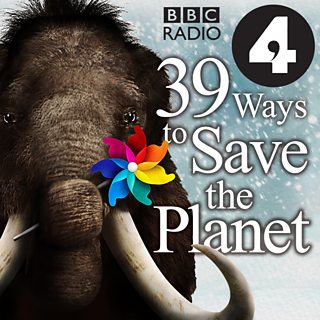Five easy ways you can help fight climate change
This page is intended for use by readers who are using screen reader technology. For a link to the original article, click here.
39 Ways to Save the Planet looks at the brilliant methods that people are using to reverse the effects of climate change. But while climate change is absolutely a global issue, that doesn't mean that individuals are powerless in the fight to help the environment.
We've got some tips from environmental scientist Dr Tara Shine, author of the book How to Save Your Planet One Object at a Time. As part of our 'Climate Solutions' collaboration with , we've turned these tips into five illustrated examples of how you can make an environmental difference.
For those using screen reader technology, we've included a summary of each illustrated image in the text below.
1. Clean using vinegar
Illustration by Amelia Flower ()
Image 1
An older woman proudly shows a bottle of cleaning vinegar to a young man. The man is clutching bottles of cleaning products, looking at the woman with a curious expression. Text above reads: “Canny Granny's Top Cleaning Hacks: Save Money and the Planet!”
Image 2
Colourful bottles of cleaning products are shown. Text reads: “Shower spray. Toilet cleaner. Fabric softener. Oven cleaner. Worktop cleaner... The list of modern cleaning products is endless. They all cost us money, tend to come in single use plastics and…”
Image 3
Chemicals from cleaning products wash out into the environment through waste water, killing plants and flowers. Text reads: “Many contain harmful chemicals which wash out into the environment, killing more than just bacteria. So take a tip from Granny and Gramps – you can save money and clean almost anything with vinegar and bicarbonate of soda!”
Image 4
An oven with two pans on the hob, and an orange, a lemon and a grapefruit in the lower right corner. Text reads: “Make Your Own All Purpose Cleaning Spray – 1/2 vinegar, 1/2 water + lemon juice. Fresh. Oven Cleaner – coat inside with a paste of bicarb and water. Leave overnight. Scrub. Totally works! Toilet Cleaner – 1/2 cup of bicarb with 1/4 cup of vinegar. Scrub as the mixture fizzes. Add essential oil for a fragrant hit.”
Image 5
The younger man is shown again, this time showing off his sparkling kitchen. Text reads: "Other cleaning tips. Vinegar is an excellent descaler. Just spritz, leave and wipe away. Bicarb absorbs smells, and is a gentle abrasive on sinks, baths, pans… Sparkling house. Money saved. Result!”
2. Change the way you make tea
Illustration by Rohan Dahotre ()
Image 1
A worried looking shark and fish swim around a teabag inside a glass tea cup. The label on the teabag shows a question mark. Text above reads: “Tea Tips: How can our favourite brew be more friendly to the planet?”
Image 2
A teabag with a sad fish inside is surrounded by other plastic items – a plastic bottle, plastic fork, toothbrush and a cue tip. Text above reads: “Most teabags contain plastic and aren’t biodegradable – yet in the UK 96% of us use them for every cup.”
Image 3
A luscious rainforest is growing out of a glass tea cup. Text above reads: “Switching to loose-leaf tea gives a tastier brew, and the leaves can then be composted.”
Image 4
A glass teapot with loose leaf tea in the bottom also has a happy planet earth inside it. Text above reads: “Only boil the amount of water you need and you’ll reduce your energy bills and emissions! Fairtrade varieties help ensure your tea leaves are kind to people as well as the planet.”
Image 5
A teabag rests on the seafloor with happy fish, shells and a turtle swimming around it. This time the label on the teabag shows a "compostable" symbol. Text above reads: “Otherwise look out for new, plastic-free compostable teabags, and avoid over-packaged and individually wrapped teabags.”
3. Do less laundry
Illustration by Dandy Doodlez ()
Image 1
Two very fed up looking people sit in front of a huge pile of laundry. They are wearing rubber gloves and have several laundry projects around them, one of which has spilled on the floor. Text reads: “Hate doing laundry? Here’s the perfect excuse to do less.”
Image 2
A washing machine pours a pink stream of microfibers into a white dish, and a fish is slurping the microfibres up through a plastic straw. Text reads: “More than 60% of the world’s clothes are made from synthetic fabrics. In every wash they shed plastic microfibers that can end up polluting our oceans... even finding their way into some of our seafood!”
Image 3
A person sits in a comfortable armchair with their feet up and a cup of tea nearby. Behind them is a washing machine with a small basket of laundry. Text reads: “What’s more, washing machines and dryers use a lot of energy – raising our carbon footprint. So why not do less and... relax instead?!”
Image 4
A white T-shirt with a small brown mark on it is being studied with a magnifying glass. Around this are several pink clothes pegs. Text reads: “Top tips: 1. Wash your clothes less! Spot clean stains rather than washing the whole garment (also extends the life of your clothes.) Air dry your clothes outdoors to get rid of odours. Fresh!”
Image 5
An outdoor washing line sports lots of colourful clothes. Below it is an empty laundry basket with several clothes pegs. Text reads: “ 2. Hang washing out to dry naturally. 3. Wash full loads. 4. Use cooler temperatures (30 degrees Celsius). 5. Consider a mesh bag designed to catch those pesky microfibers.”
4. Shop seasonally
Illustration by Sarina Mantle
Image 1
A woman in the grocery aisle places a leek in her shopping basket. Behind her a man is struggling with a giant asparagus that has a ‘Made in Peru’ label. Text above reads: “Find out what’s in season locally for a tasty shop with a lighter footprint”
Image 2
Two hands holding a knife and fork reach towards a plate of vegetables. Text reads: “Eating a diet that’s more plant-based can lower your environmental impact. But to supercharge your planet-friendly diet, it helps to know your air-freighted asparagus from your boated bananas and local leeks.”
Image 3
A different lady clutches another leek and looks to the side. Behind her more giant asparagus are being flown in strapped to a plane, while giant bananas and oranges are travelling in a boat across the sea. Text above reads: “Because it’s flown in, an asparagus bought in winter has a carbon footprint 16 times higher than that bought locally, in season. Less perishable foodstuffs like bananas and oranges can travel from abroad by boat, with much lower impact.”
Image 4
A hand holds a wooden basket laden with lovely-looking veg. Text above reads: “Know when food is in season. Traditional recipes are often a good clue! Out of season food that’s fresh and fragile, like berries, asparagus and green beans, tends to be air-freighted.”
Image 5
Four small images show an open fridge full of fruit and veg, a kettle boiling water, a hand writing a list and a knife chopping vegetables. Text reads: “Eat everything you buy. In the UK a third of the food we produce is thrown away. Check your fridge, write a shopping list and get creative to reduce food waste.”
5. Don't just throw your old shoes away
Illustration by Kingsley Nebechi ()
Image 1
A colourful cartoon centipede is checking out the many trainers in his closet. Text above reads: “Would you rent a pair of shoes? Tips for treading lightly on the planet.”
Image 2
A single red and white trainer is on a display surface with a "£££" price tag. Text reads: “Over 20 billion pairs of shoes are sold each year. Many are made of synthetic materials and are worn just a handful of times before being thrown away.”
Image 3
A pair of trainers pokes out the top of a bin. Through a window behind we can see piles of shoes building up against the city skyline. Text reads: “Some shoes can take as long as 1,000 years to break down in landfill, so they could still be there in the year 3021! How many pairs are you donating to the next millennium?”
Image 4
Colourful trainers are lying on a display surface. Text reads: “So how can you step out stylishly but with a lighter footprint? 1. Recycle or donate pre-loved shoes (many brands have recycling schemes). 2. Research before you buy – some brands are more sustainable! 3. Borrow (or rent) a pair for special occasions."
Image 5
The colourful centipede is out running in a park and picking up litter as he goes. Text reads “If you're feeling active, why not put your trainers to new use by "plogging" – the Swedish-inspired workout that combines jogging with picking up litter!”
For more fascinating climate solutions, listen to 39 Ways to Save the Planet on ����ý Radio 4.
More eco-friendly content
-
![]()
39 Ways to Save the Planet
Tom Heap and Dr Tamsin Edwards uncover fresh ways to save the planet from climate change.
-
![]()
Our Planet Now
The ����ý’s ongoing focus on the environment and the challenges facing our planet.
-
![]()
Royal Institution Christmas Lectures: Planet Earth – A User's Guide
Watch Dr Tara Shine's lecture on the gases that make up the air we breath.
-
![]()
Explore more on environmental issues and climate change with The Open University.





